Living as a Croatian in South Africa: Part One - Introducing Ova Klapa
June 28, 2022 - In a new TCN series, intern Adriana Tasovac talks about living as a Croatian in South Africa.
My earliest memories of my childhood are with mixed feelings. Although my childhood within my family and Croatian community was very joyful and content, it was difficult for me initially to blend in with my South African peers at school, as they were all English speaking and I had only spoken Croatian until the age of two. Children can be brutal and unfiltered and most unaccepting of someone that does not blend in with their norm, which is what I was, with my unpronounceable name and lack of common language. Today as an adult I can laugh off the awkward childhood as my upbringing within my Croatian community as a Luška (Female from Vela Luka) is what stirred up my strong feelings and absolute love of my roots and rich heritage and culture. Living as a Croatian in South Africa has been a very positive experience, which has taught me the importance of embracing other heritages, cultures, and countries, and the significance of loving who you are.
Velo Lučani (Croatians from Vela Luka), are bound by a common love for singing and acapella choirs. Gathering with our friends and family, was always a frequent occurrence. Every opportunity was taken at any given time, to get together where much eating, drinking, and singing took place. Upholding the traditions from home seemed to fill the void of living in a foreign country. It was these joyous get-togethers that prompted a group of close-knit Lučani friends, including my father to start their singing journey.
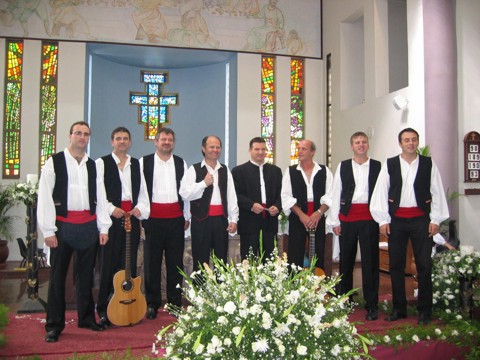
Soon after, they gave their group a name, and "Ova Klapa” (This Acapella) was born. Ova Klapa ignited my interest in music, particularly our traditional folk music. The klapa (acapella group) would sing traditional folk songs after dinners during our many gatherings, which in turn prompted them to record a compilation of their favourite and most revered songs in an album.
One very fond memory has always remained with me, Ova Klapa’s introduction of themselves and their complete cover album ‘’Jo, Da Mi Je” (Oh, How I Wish), as well as some teaser songs from their then-upcoming, second cover album, to the South African- Croatian community at the Saint Jerome Croatian Catholic Church in Johannesburg.
(Part 1)
A memorable concert was organised and performed on the evening of the 28th of February 2004, which told the story of their love for Vela Luka and their longing to return someday.
(Part 2)
This nostalgic and emotional event showcased a variety of songs from their cover album as well as their appreciation of South Africa, by including a native South African choir to perform some of their own traditional dances and recitals. There were many laughs and tears throughout the journey of the tale that they told, and the concert concluded with their rendition of ‘’Sjećanje na Velu Luku’’ (Remembering Vela Luka).
I recall waiting patiently all night for my big moment to arrive. All the children of the members of Ova Klapa, were dressed in traditional outfits and given the task of presenting all the ladies and benefactors with a bouquet of flowers. I proudly executed my duty and then spent the finale in my father’s arms gazing into the audience. “Vela Luku, mala, ne zaboravi!” (Little Vela Luka, I won’t forget you!).
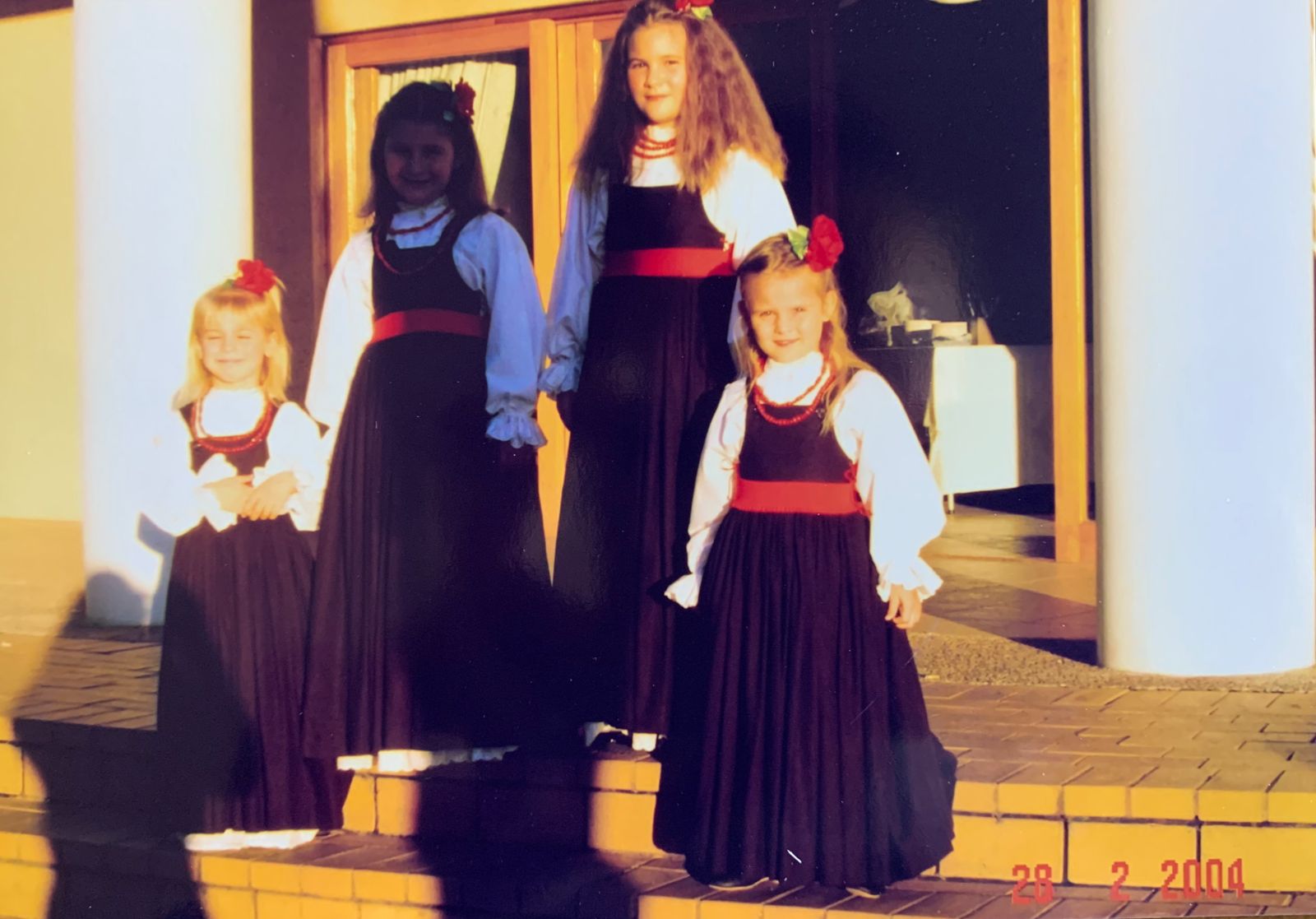
For more, check out our lifestyle section.
Contents of a Slavonian Easter Basket: From Eggs to Green Onions
15th of April 2022 - The most important Christian holiday is almost here which means plenty of food and traditions that have been part of Croatian culture for centuries are in focus. A look at the contents of a Slavonian Easter basket.
With Lent being over on Palm Sunday, Holy Week and the final days before Easter have begun. Of course, that means believers who participated in relinquishing and fasting during Lent can finally start eating normally, except on Good Friday when fasting is strictly prescribed. Preparations for Easter include a lot of cooking and preparing sweet pastries to celebrate Jesus’s resurrection. Good Thursday is dedicated to the remembrance of Christ’s Last dinner and no one can work on their soils or crops. As already mentioned, Good Friday includes a strict fast with only one proper meal allowed, which symbolizes Jesus’s torment and death. After Good Friday, Good Saturday is reserved for silence and preparations of said meals that have everything from heavy meat to spring vegetables and more. However, the most important part of the Easter celebration is definitely an Easter basket, which contains a variety of foods reserved for blessing and later for Easter celebration, most commonly as a breakfast on Easter itself.
Easter Eggs
Most things in the basket are definitely Easter eggs (pisanice), or boiled chicken eggs with beautiful handmade designs that differ from family to family. This custom of decorating and gifting eggs was known throughout Europe, especially among Germans, Scandinavians, and Slavs. Even its age is confirmed by archeological grave finds. When it comes to Christianity, the egg is a symbol of the new and eternal life that Jesus made possible for people through the resurrection. In Croatian traditional culture, the custom has remained to this day. In the past, only domestic homemade colors were used for painting eggs and they were obtained from broccoli, onion peel, nettle, various grasses, and many more. Aniline dyes became popular much later. Wax was applied to the egg by a special funnel-shaped pen or pinhead; this technique also made it possible to obtain multicolored ornament. These traditional ways of painting Easter eggs came back - more and more people fall back to old customs because of healthy and more organic ways of painting. On Easter morning, eggs are put to use - children break eggs to determine who has the strongest one.
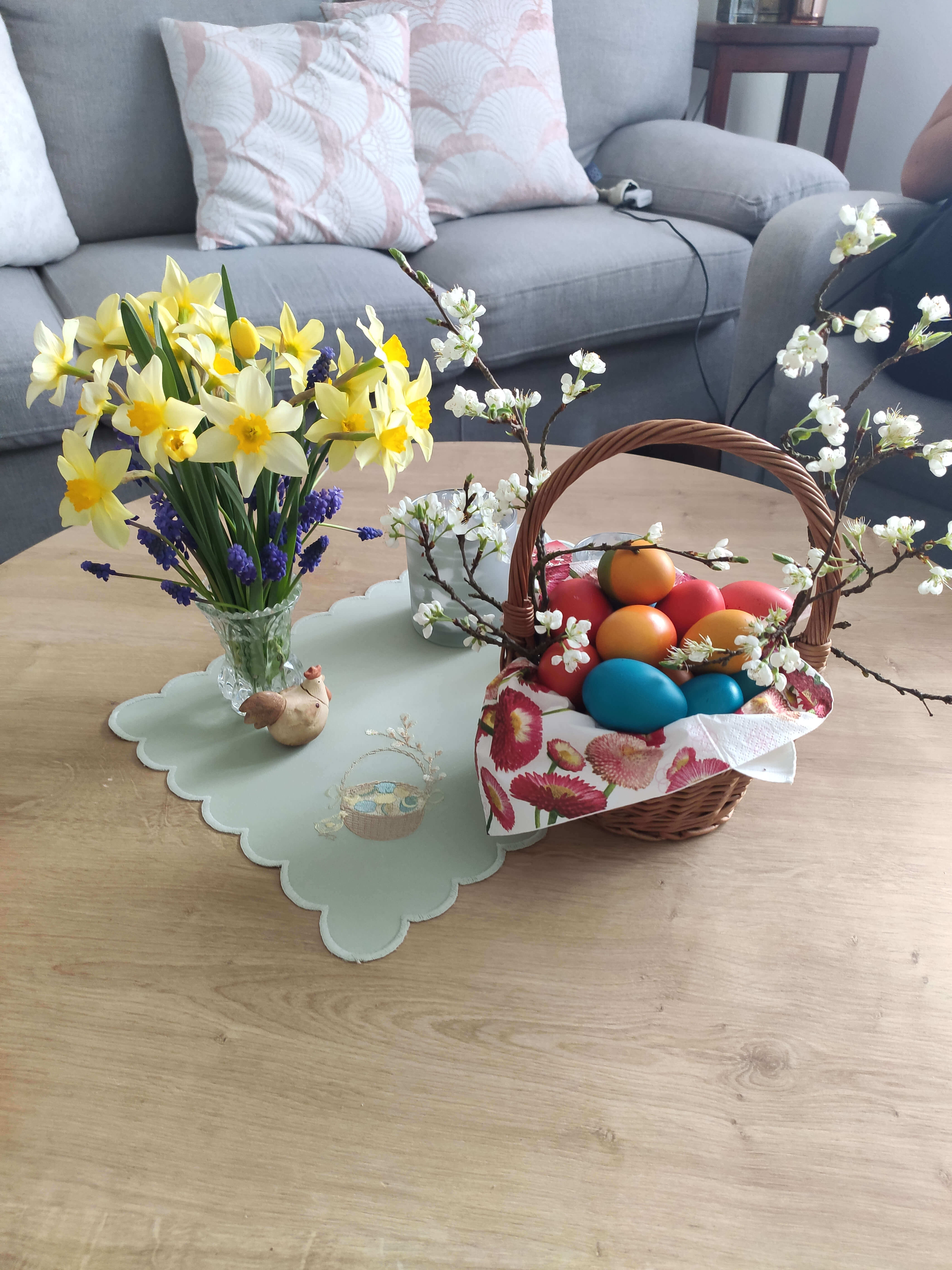
Colored Easter eggs and spring flowers on Easter (photo credit: Private album)
Unleavened bread
As we know a lot of Christian traditions are shared with Jewish customs and unleavened bread is part of that as well. It symbolizes Christ’s body and according to Bible, was present at Christ’s Last dinner. There are a lot of variations of bread throughout Croatia like normal pogača, pinca, however, unleavened bread is a customary Easter bread in Slavonia and represents sacrifice. Its texture is somewhere between hard and soft and has a neutral flavor which fits amazingly well with other Easter basket components.
If you’re interested in making this bread, here is my family’s recipe that’s been used every Easter for decades:
0,5 kg of smooth flour
1 package of baking powder
1 teaspoon of salt
4 egg yolks
1 egg
1 tablespoon of pork lard
10 dag of butter
Method:
Mix with milk so that it is neither soft nor hard. Let it sit for 10 minutes, after that put it in a small bowl with a diameter of 18 cm. Grease the bread really well with lard and put the bread in the oven preheated to 180°C. Bake it for 30 minutes, take it out, coat it with egg yolk and milk mixture using a brush, put it back in the oven, reduce the temperature to 150°C and bake it for 25 minutes more.
There you go! You have a proper Slavonian bread that’s part of every Easter basket.
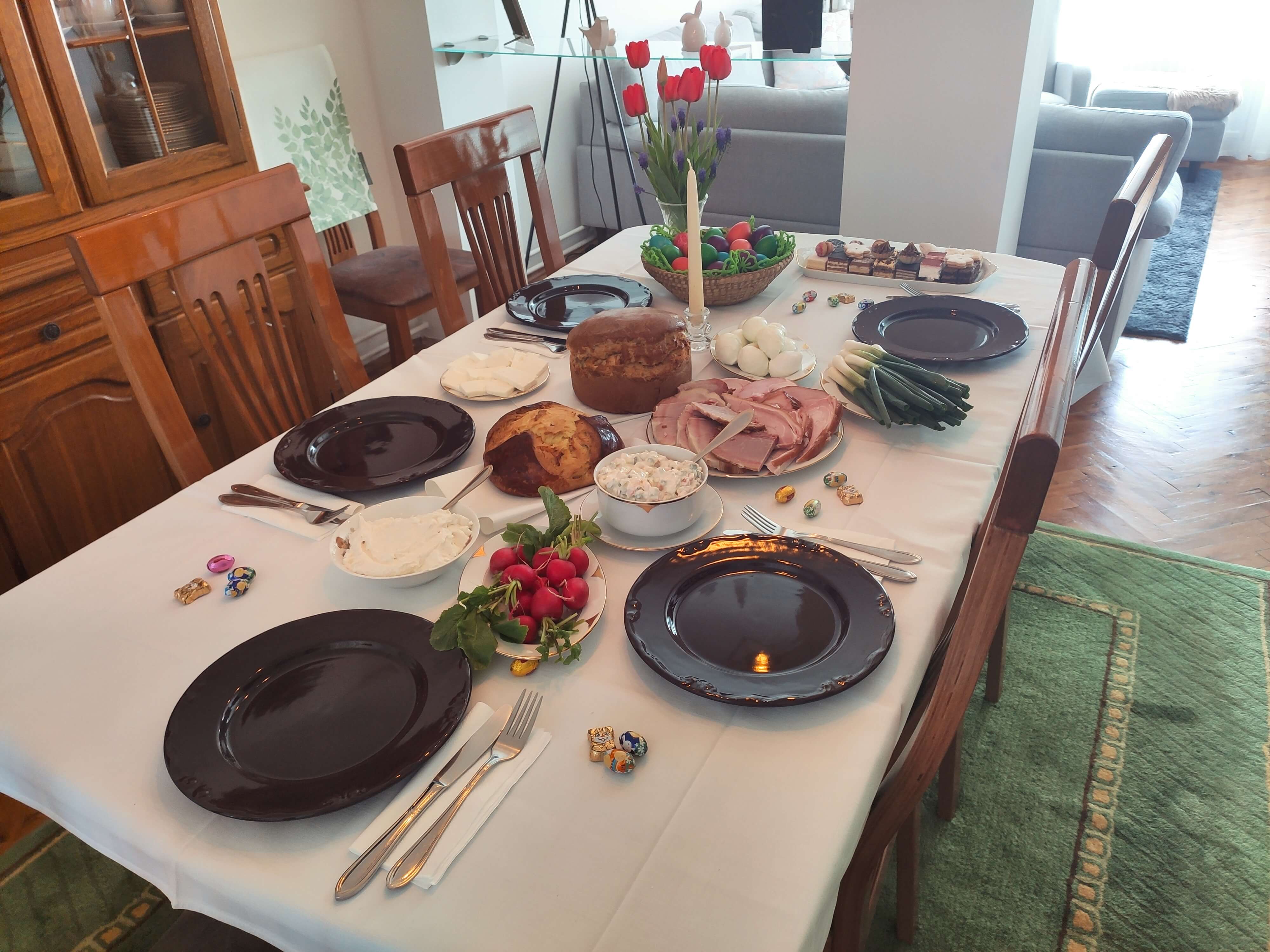
Easter breakfast with food from Easter basket (photo credit: Private album)
Ham
Fragrant-cooked ham is certainly the main star of the Easter table and what evaluates the quality of its preparation is juiciness. The type of meat is really important but the best is definitely pork meat or rather pork leg which is considered the “real” ham. Other than classic cooked ham that we know and love, there is an alternative - ham wrapped in pastry. Again, its preparation varies from family to family and the quality of the meat is determined by the financial status of the people who prepare it.
If you’re interested in the preparation of cooked Easter ham, check this recipe here.
Radish
The so-called spring queen of health and a vitamin bomb. Although radish is primarily associated with the Easter table, many people buy this vegetable because of its rich nutritional composition and medicinal properties. Indispensable food of every Slavonian Easter basket.
Green onion
If it's planted before Spring, green or young onions are definitely an unavoidable vegetable for the Easter basket. Strong, spicy, and its intensive smell with ham bring something really special to every Slavonian household on Easter. Like radish, it is a great ingredient in a variety of Easter salads.
Sweet cakes and pastries
Last but not least, cakes and pastries are a must in every Slavonian Easter basket. From usual pies like cakes like mađarica, chocolate pie, white pie, honey pie, so-called Katherine (Katarina kolač), and coconut-walnut cubes that were and still are a staple for Slavonian desserts through decades, small cakes, pastries, and cookies are getting more and more popular in recent years. Likes of išleri, baskets (košarice), rum balls, linzers, triangles and so many more. Cherry or apricot strudel is also a recent pastry baked and consumed on Easter. Breskvice (peaches) as well - signature Slavonian cake.
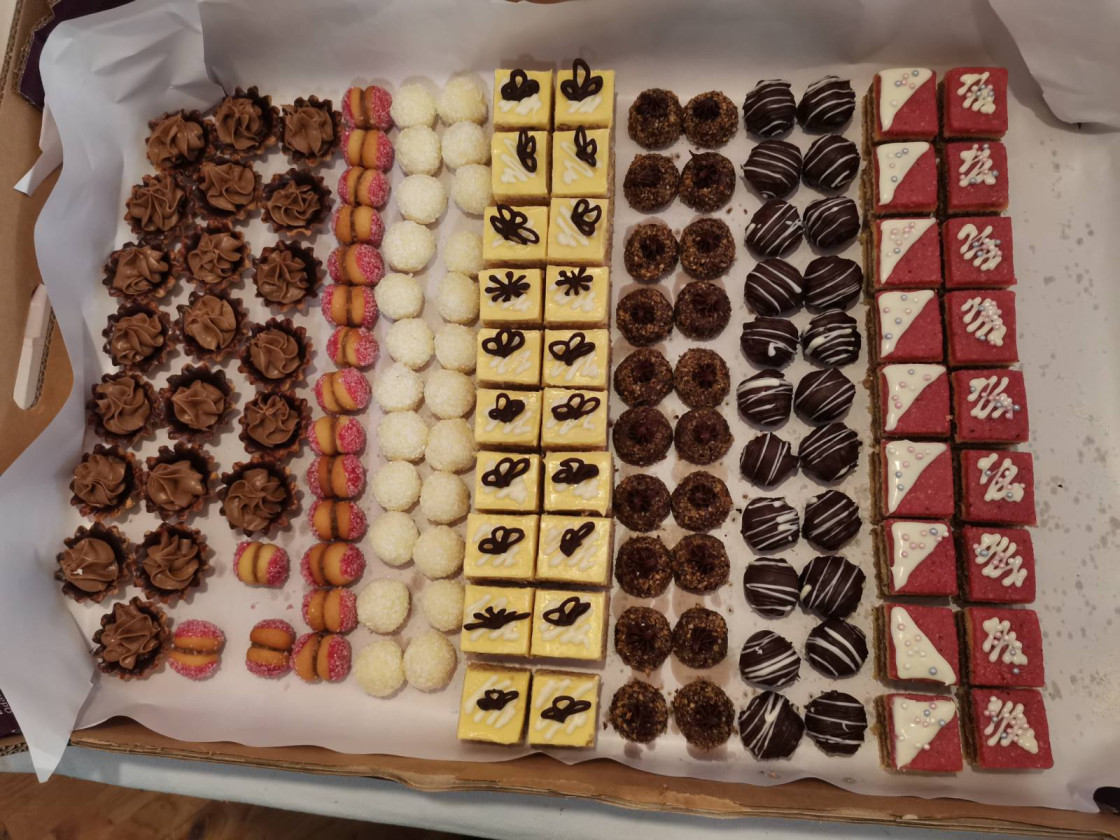
Sweet cakes and popular pies in Slavonia (photo credit: Private album)
Salt is also part of the blessed Easter basket with candles that will be lit on Easter breakfast and other various items that believers want to bless.
As said in the beginning, Easter is the most important Christian holiday. It celebrates Christ’s sacrifice and resurrection. Throughout the centuries, Croatians managed to save huge parts of their cultural and traditional heritage and it’s not a coincidence that Easter customs are one of the oldest traditional practices in Croatia’s history. It doesn’t matter if you’re not a believer, everyone is welcome to try the contents of a Slavonian Easter basket, take it, and in the end, try to make these delicious meals for themselves. At the end of the day, this is the time, not just for sacrifice, but for sharing and love as well.
Sretan Uskrs!
For more about lifestyle in Croatia, visit our dedicated TCN page.
Traditional Festivities in Slavonia - Unmissable Events
7th of April 2022 - There are a lot of festivities you can visit in Slavonia - from beer and food festivals that became really popular in recent years, to modernized cultural manifestations which teach us something new. However, traditional festivities in Slavonia which are held for more than half a century, are still an irreplaceable staple of this region.
When reviewing the list of festivities in Croatia, a tourist or even a Croatian citizen, is shocked by the variety and content Croatia organizes every year for their visitors. Urban, cultural, and gourmand festivals are in forefront of most tours and offers, especially with summer coming soon and since Croatia became a really popular destination among tourists, they also got more interested in the tradition and cultural heritage of the region they visit. For instance, Dubrovnik, which is a jewel of the Adriatic coast, not only attracts visitors with its gourmand offers or beautiful historic sites like Tvrđava, they also have the Dubrovnik Summer Festival (Dubrovačke ljetne igre) which brings visitors closer to tradition and the way native people of Dubrovnik lived centuries ago. This event brings Dubrovnik back to the golden age of renaissance and baroque, the living spirit of drama and music, and many more, which were bestowed upon Croatian cultural and scholarly history. That’s why Dubrovnik is so good at tourist offers, they bring everything to everyone.
However, with different tourists comes different tastes and recent years showed an increase in interest in Eastern Croatia, more precisely, Slavonia and Baranja, which are labeled as more “rural, folk” regions. Slavonians and Baranians recognized the potential these regions have and started adapting to tourists' wishes and needs. Yes, they devised and organized multiple new festivals that will be held for many years to come but they realized their traditional festivals, which are really popular with lovers of everything related to tradition and locals, need more exposure.
Đakovački vezovi - Đakovo
Today, Đakovački vezovi is a well-known and affirmed manifestation of original folklore. The first manifestation occurred in July 1967, as part of then the International Year of Tourism and from the beginning, the event was a great success with people from Slavonia and beyond. The main event kept its original date and it’s held every year in July. Contents of the festival include original folklore from Slavonia, Baranja, Western Srijem, and other parts of Croatia with accompanying events such as the opening of various exhibitions, equestrian events, and other cultural and tourist events. The entire city participates in the event and in 2005, it received the International Tourism Charter (European Federation of Tourist Journalists based in Rome) Merits for Tourism. Thousands of folk costumes pulled from the chest of oblivion, thousands of participants from Slavonia, Baranja, the whole of Croatia, even Europe, and the world, bring us songs, dances, and customs of their homeland for decades in Đakovo. If you’re a gourmet, you’re settled. Hundreds of different dishes are served and ready for degustation. Wine lover? Multiple winemakers with their best wines are ready to show off their products which are a reflection of the beautiful, rich region of Slavonia. Artists, folk, history lovers, and even animal lovers can come and have the time of their lives which makes it one of the largest and most popular traditional festivities in Slavonia. For more details, check out their official website.
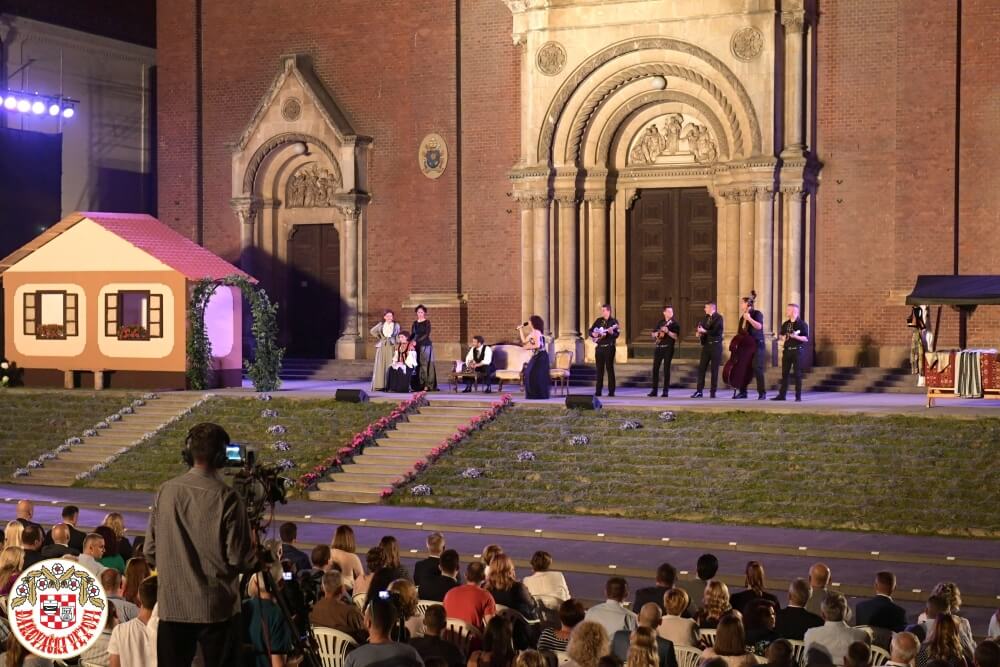
The opening of "Đakovački vezovi" in 2019 (photo credit: Photo Gallery - djakovacki-vezovi.hr)
Vinkovačke jeseni (Vinkovci Autumns) - Vinkovci
Definitely, the largest cultural event in the region, arguably in Croatia and some would say, in this part of Europe. The First Vinkovačke jeseni was organized in September 1966 and soon became one of the most famous festivals of its kind in all of Croatia. The foreground of the manifestation is the care of traditional folk dances, costumes, and customs in order to preserve various values of folk and traditional life of Slavonia. What’s really interesting is the fact that the manifestation is organized in September because of autumn - a season that rewards Slavonians for their hard work. After its founding, the festival soon began to connect all lovers of cultural heritage, not just Slavonia, but all the regions in Croatia. So every year hundreds of Folklore Societies from Croatia, Serbia, Bosnia and Herzegovina, Slovenia, and many more come to Vinkovci to display their culture to visitors. However, they didn’t stop there. Organizers recognized the tourist potential of their event and upgraded it for modern times, so apart from the main event which signifies a closure of Vinkovačke jeseni, the whole week before the opening is dedicated to its visitors! For instance, the opening of the event comes with a big performance by the local theatre with other guests from all over Croatia and in the evening the concerts of the biggest Croatian music stars begin, every evening of the week! Personally, I watched biggest Croatian performers on Vinkovačke jeseni stage like Dino Dvornik, Severina, Jelena Rozga, Klapa Intrade, Giuliano, Prljavo Kazalište and so many more. It truly is for everyone. Then, when the show of the manifestation ends on the last day of the week with the biggest folklore parade in this part of Europe (nationally televised), with the most popular folk and traditional commentator in Croatia, Branko Uvodić, every visitor feels enriched with Slavonian tradition, cultural heritage, food, art, folklore and more. That’s why Vinkovačke jeseni is one of the biggest traditional festivities in Slavonia and one of the best representatives of Croatian traditional, cultural heritage in this part of Europe. For more details, visit their official page. If you want to read more about Vinkovci, check this TCN article.
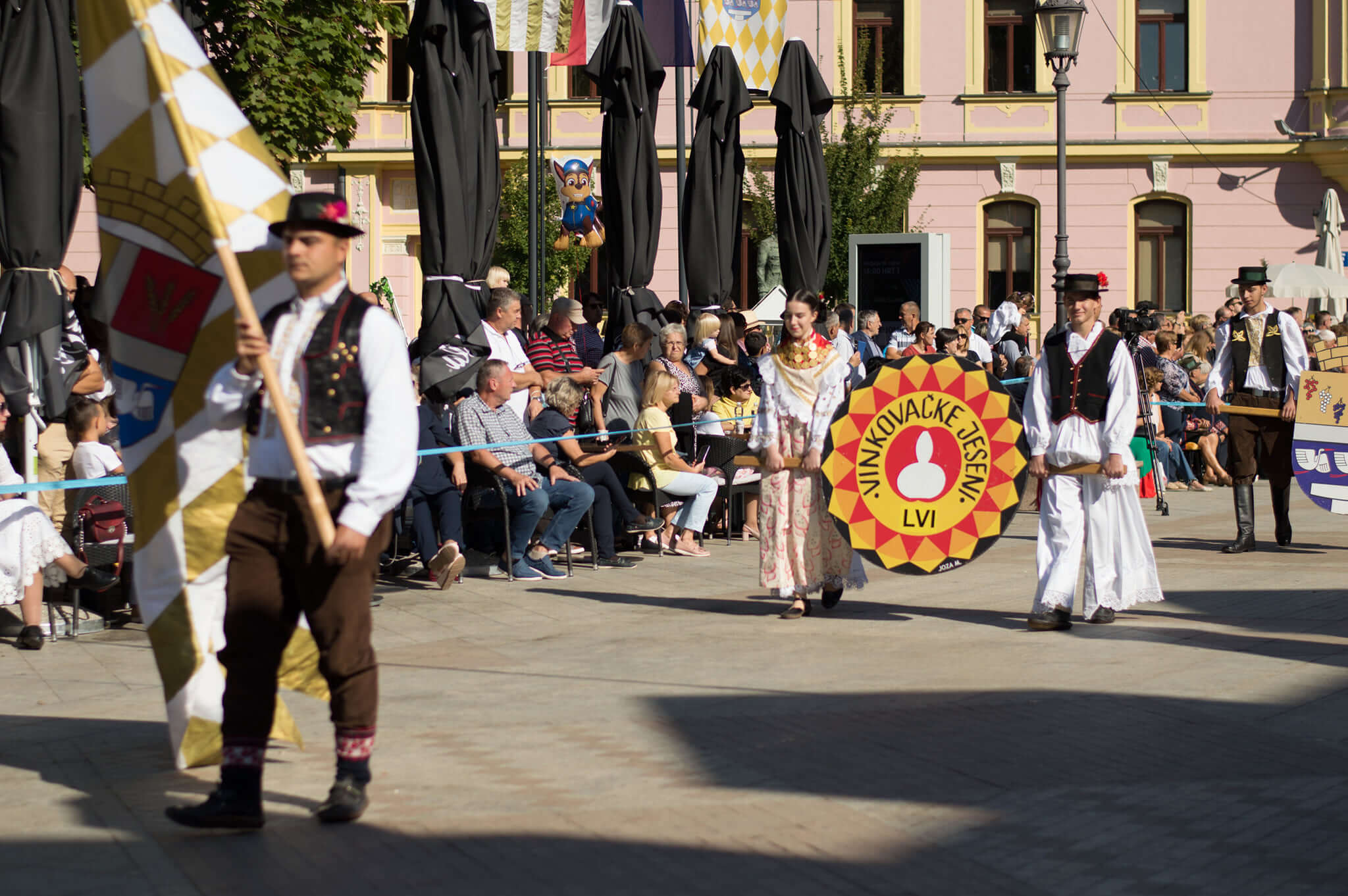
"Vinkovačke jeseni" parade - the main event on the last day (photo credit: Vinkovačke Jeseni - Facebook page)
Aurea Fest - Zlatne žice Slavonije (Golden Wires of Slavonia) - Požega
In the middle of Slavonia lies the city of Požega, located in the hilly parts of the region where none of the roads are straight - a place where hills are dotted with roads. Surrounded by the old hills of Psunj, Papuk, Krndija, Dilj, and Požeška Gora and home of the famous Croatian poet, Dobriša Cesarić, it doesn’t seem odd that this city is the home of one of the biggest traditional, cultural and musical events of folklore, tamburitza but also pop music, which has been held in Požega since 1969, with a break between 1981 and 1990. Zlatne žice Slavonije today is a four-day event with more than 40,000 visitors and more than 100 accredited journalists from several countries. Songs, top-tier wines, gastronomy events, concerts, exhibitions, art colonies, sports competitions, folklore festivals and other events are slowly making Požega and the Golden Valley one of the tourist destinations in Croatia in September. It hosted multiple Croatian musicians (mostly “tamburaši”) like Gazde, Zlatni Dukati, Miroslav Škoro, Slavonske lole and so many more. CDs and cassettes were pretty popular back in the day, which meant that almost every Slavonian household had a copy of musical repertoire from Golden Wires of Slavonia! So, if you visit Slavonia, definitely visit Požega in September - great content, songs, dances, food, and most importantly, people. The main event, the concert, is nationally televised on HRT every year. For more information, visit their official page.
For now, we’re stopping here. There are a lot of traditional festivities in Slavonia but these three events are staples of traditional festivities in Slavonia and the whole of Croatia. From entertainment to food and sports recreation, these manifestations are unmissable events if you want to visit Slavonia. Slavonian spirit cannot be recreated anywhere else, so if you want to relax further after a summer tour of the Adriatic, come to Slavonia, they’re going to welcome you with open arms.
For more, make sure to check out our travel section.
Olive Oil from Brač Island Registered with Protected Designation
ZAGREB, 31 January, 2022 - "Bračko maslinovo ulje" has been entered in the register of protected designations of origin and protected geographical indications, which makes it the 33rd Croatian food product to be entered in the register, the Ministry of Agriculture reported on Monday.
The European Commission published its decision in the EU Official Journal of 31 January, noting that 'Bračko maslinovo ulje' has been entered in the register.
Bračko maslinovo ulje is an extra virgin olive oil obtained exclusively using mechanical processes, with at least 80% of the product being made of the "oblica" variety of olives.
This olive oil can be produced only on Brač Island. Olive growing has become a symbol of the island and its most common variety is the "oblica" or "Brač" olive, which is registered in the world catalogue of olive varieties, the ministry reported.
Croatia now has 33 agricultural and food products registered in the European Union as a protected designation of origin or protected geographical indication.
Varazdin Old Town Nominated For Croatia's Second European Heritage Label
January 11, 2021 – Comparable to UNESCO's World Heritage List, the European Heritage Label is given to sites that have played a significant in the history, culture and values of Europe. If successful, Varazdin Old Town will be only the second site in Croatia to receive the classification
They say that Northern Croatia has more castles, fortresses and stately homes than any other region in the country. And they are probably right. Not that the names and locations of all are widely known either in the country, and certainly not outside. Truth be told, some of the structures included on Northern Croatia's list of important buildings have lain derelict for centuries. In others, the decline has been more recent. The best way to preserve such buildings seems to come from reimagining them for contemporary use, rather than simply preserving them in aspic or amber.
That is something that Varazdin Old Town does extremely well. All of Northern Croatia's famous castles do this well - Čakovec castle, Trakošćan, Veliki Tabor and Gornja Stubica. It's the reason they are famous. By opening up their doors as museums and event spaces, they attract hundreds of thousands of visitors each year and they get to tell their stories. And the story of Varazdin Old Town makes it perfect for the European Heritage Label.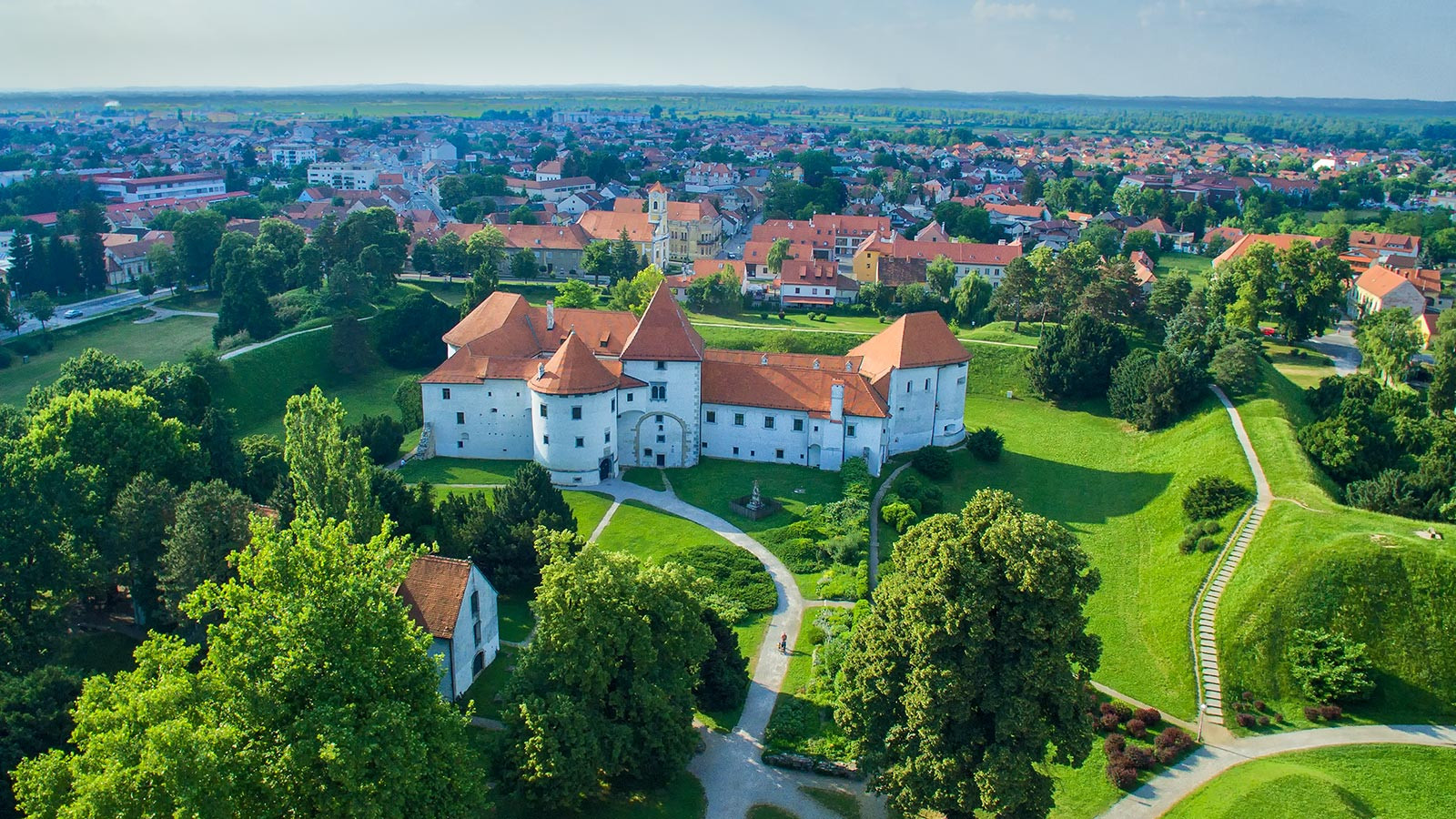 © Ivo Biočina / Croatia National Tourist Board
© Ivo Biočina / Croatia National Tourist Board
Varazdin Old Town is today inhabited by the Varaždin City Museum. They give guided tours around the fortress that was once the full extent of Varazdin Old Town. This city museum is the best way to learn about Varazdin's extraordinary buildings, culture and history. The museum has undertaken this role, and that of preserving items from Varazdin's past, since 1925. It has four permanent exhibitions and six major departments – Archaeology, History, Cultural History, Ethnographical, Entomology and the Gallery of Old and Contemporary Masters, some of which are inside the Old Town fortress itself.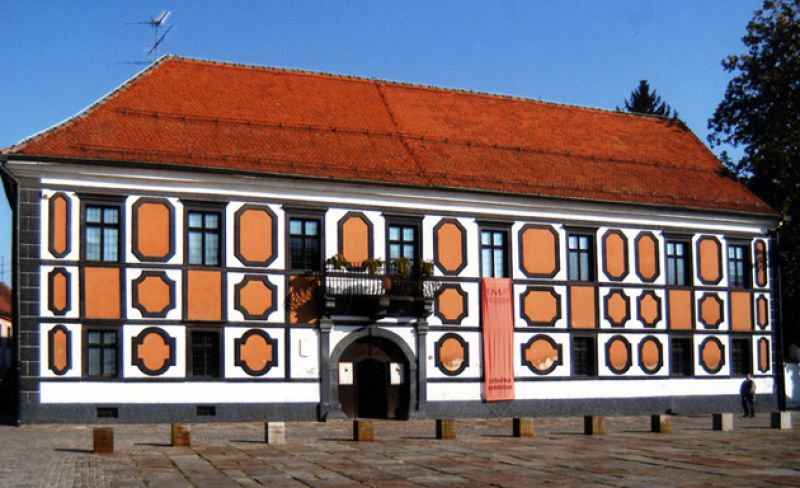 The Gallery of Old and New Masters of Varaždin City Museum © City of Varazdin Tourist Board
The Gallery of Old and New Masters of Varaždin City Museum © City of Varazdin Tourist Board
The Old Town fortress itself is medieval in origin, its construction having begun in the 14th century. Its Gothic towers were added a century later and the collection of buildings was remodelled and added to right up to the 19th century, in response to its inhabitants and its purpose.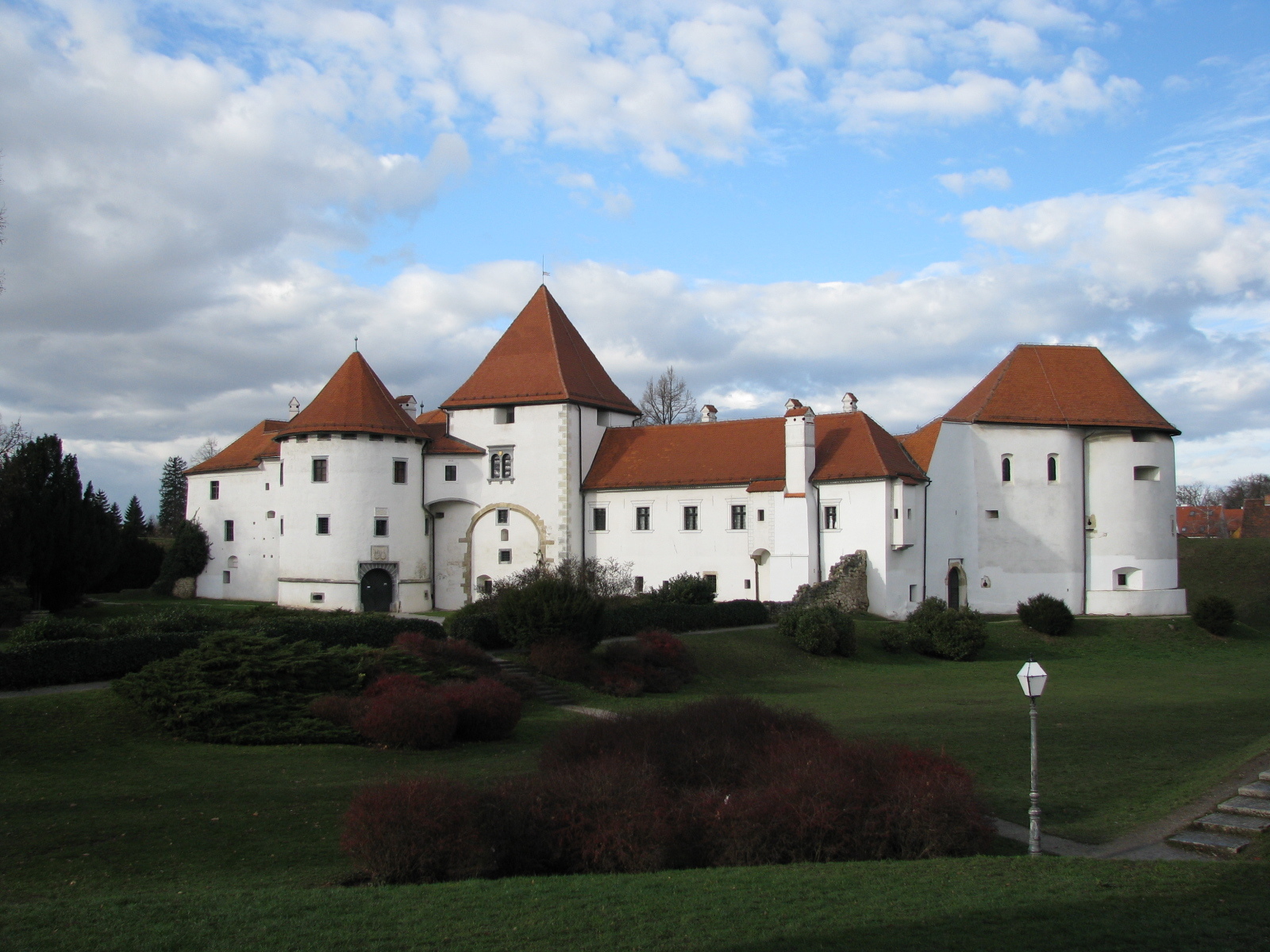 © Ex13
© Ex13
For defence against the Ottomans in the 16th century, it was reconstructed as a Renaissance fortress – high earthen walls with bastions were added, and a double moat. During the past, many noble families have lived here - the Counts of Celje, John Ungnada, George of Brandenburg and Croatian Ban Thomas Erdödyja and his successors. Indeed, Varazdin was once the capital city of Croatia, ruled from these very buildings. In its changing use, architecture and occupancy lies the story of not only the development of Croatia but that too of Europe and it is this that makes Varazdin Old Town eligible for the European Heritage Label.
The European Heritage Label is awarded to sites that bring to life the European narrative and the history behind it. The European Heritage label is currently awarded only every two years. So far, the only site in Croatia to receive the European Cultural Heritage Label from the European Commission is the Neanderthal Museum in Krapina. Its label was awarded in 2015.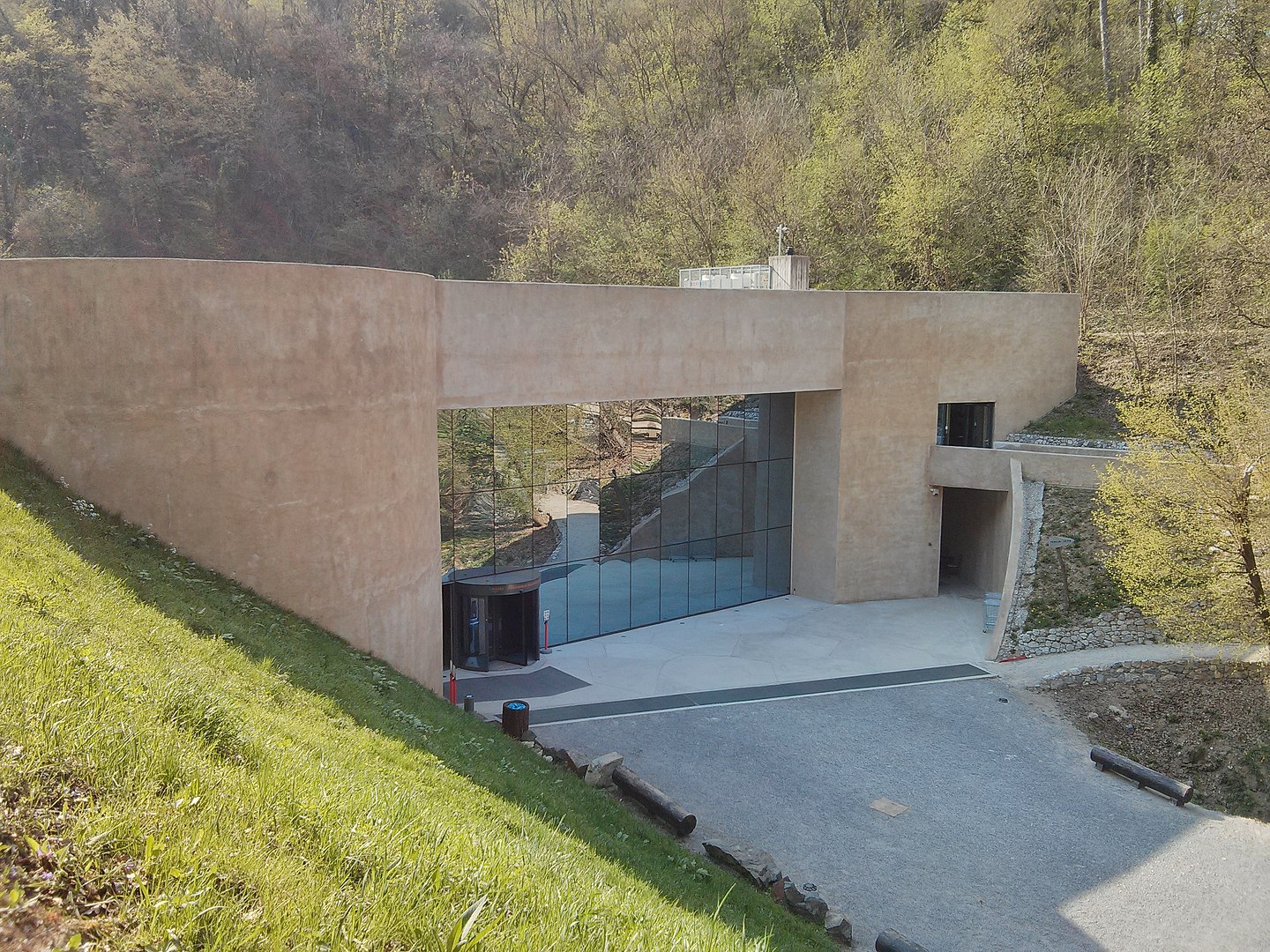 The Neanderthal Museum in Krapina, also in Northern Croatia. It received its European Heritage Label in 2015 © Zeljko Filipin
The Neanderthal Museum in Krapina, also in Northern Croatia. It received its European Heritage Label in 2015 © Zeljko Filipin
VIDEOS: Amazing New Google Project Shows Croatian Culture to the World
September 18, 2020 - Incredible new video series explore Croatian culture, its natural assets, and the country's rich traditions, a collaboration with Google
Steeped in history and tradition, Croatian culture is incredibly diverse. Recognised as being of high value to the country's appeal and its understanding of itself, many items from this rich heritage appear on the protected UNESCO list.
The Croatian National Tourist Board has teamed up with Google Arts & Culture and partners The Museum of Arts and the Museum of the Sinjska alka to produce an incredible series of videos that explore this cultural heritage.
From arts & crafts to music and dance, natural assets and architecture, the new videos show off the rich menu of traditions assets that make Croatia such an incredible country. With so many items included on the protected UNESCO list, there's always something more you can learn about Croatia, no matter how many times you visit.
Lace-making, costumes of folklore, ancient instruments, time-honoured recipes, beloved festivities and distinct, regional styles of music are just some of the facets of Croatian culture explored in the videos. Now, people from all over the world can explore Croatian culture and heritage before they even arrive. The menu of videos and accompanying media is presented in both English and Croatian.
Some of the videos in the series are not new, but they have been selected by the Croatian National Tourist Board for inclusion as they are the best at showcasing their particular aspect of Croatian culture. Alongside the video presentations, there are a wealth of photographs and informative texts. You can view the whole new collaboration with Google Arts & Culture here
For the latest travel info, bookmark our main travel info article, which is updated daily.
Read the Croatian Travel Update in your language - now available in 24 languages
Hvar's Arsenal Wins European Heritage Award
May 8, 2020 — Hvar's Arsenal won a “Europa Nostra” award, the continent’s most prestigious prize in the heritage field, honoring the rejuvenation an unavoidable focal point in the city’s port.
One of Hvar’s enduring symbols won in the category of “conservation” for the renovation and strengthening of the Arsenal’s load-bearing structure.
The “Europa Nostra” awards recognize successful conservation and restoration initiatives. Hvar’s Arsenal joins 21 other projects in 15 countries which also earned a “Europa Nostra”. It’s now eligible for the Public Choice Award, decided by an online vote on the European Heritage site.
Independent juries composed of experts from across Europe chose the winners, following a detailed evaluation of applications submitted by organizations and individuals from 30 European countries.
The jury noted that “this respectful revitalization project has adapted a very significant building to the modern needs of the community and adds a new cultural dimension to the tourism of the area. The stratification of the 16th-century building and the later 18th-century theater has been properly recognized in the conservation works.”
The City of Hvar, the Ministry of Regional Development, Split County and Ministry of Culture financed the project. Split-based Spegra carried it out. The company has rehabilitated significant structures for over three decades. It has also fixed Mostar’s Old Bridge, the Bishop’s Palace in Ston, and many other recognizable historic icons in the region.
“This is a joint recognition of the Government of the Republic of Croatia, the Ministry of Culture, the Conservation Department in Split, us in Spegra,” the company’s director Berislav Borovina said. “It is proof that we have done the right thing. The world has recognized this and placed us alongside the highest quality European companies in terms of the restoration of monumental heritage.”
The Arsenal was originally a Venetian shipyard, erected in 1292 to repair and refit war galleons until the Ottomans destroyed it. Hvar’s residents built its replacement — the current stone building — in 1612.
?#EuropeanHeritageAwards #EuropaNostraAwards 2020 winners announced!
— Europa Nostra (@europanostra) May 7, 2020
21 achievements/15 countries?ℹ️ https://t.co/W1dn24lOcF#Conservation#Research#DedicatedService#Education #Training #AwarenessRaising
?️Now it's your turn to vote for the #PublicChoiceAward@europe_creative pic.twitter.com/OEmdB4TIej
The building needed the rejuvenation. Wear-and-tear began betraying the building’s four centuries of existence. Spegra’s work added no extra weight, creating “invisible” improvements while increasing the Arsenal’s stability.
The project took decades of effort, starting with studies and a conservation report that started in 1989, a four-year reconstruction of the load-bearing structure, as well as a lengthy renovation.
The work paused after Roman artifacts and the remains of a first-century building emerged from the ground under the Arsenal.
“It is a very demanding facility that required a high percentage of skilled labor and top craftsmen and workers, and it is specific in its dislocation,” Borovina said. “The execution was very complex, and this is one exemplary example of modern renovation and strengthening of the structure for some future times.”
Its upstairs space was the first public theater in Europe, letting commoners peasants and aristocrats mingle.
The building reopened last year, joining a flood of restorations wrapped up on the 150th anniversary of organized tourism on Hvar. It included both the Arsenal and the theater, and the Hotel Palace Elisabeth.
This isn’t the first time Croatia’s won a Europa Nostra award. In fact, many of its landmark structures and events earned the designation over the last two decades, including the Alka of Sinj Museum and the Betina Museum for Shipbuilding.
First Croatian Olive Oil for Children - Brachia Kids
There's no denying that Croatian olive oil is second to none, and we're not the only ones who think it. Croatian produce has won award after award and the long coastal traditions of olive growing, picking and harvesting in Croatia are worthy of just as much praise as the final results of that hard work are.
As Morski writes on thr 4th of April, 2019, the respected Brač brand of olive oil, Brachia, has launched Brachia Kids, the first Croatian olive oil made just for children of kindergarten and elementary school age, reports Journal.hr.
''Brachia Kids brings the fresh and intriguing taste of organic olive cultivation from ecological [olive] growing from the island of Brač. These flavours are ideal for children when it comes to falling in love with the taste of olive oil. This new product is intended for parents who understand the healing properties and the great nutritional value(s) of olive oil, and who want to introduce it to their children's diet,'' said Leopold Botteri, the co-manager of the Brachia cooperative.
Part of the main role in popularising the consumption of olive oil for children will also be played by its attractive packaging, which has been made by Izvorka Jurić and Jurica Kos.
''We've designed the packaging so that the product is attractive to children, fun to use, and also educational, in order to develop their awareness of the importance of the regular use of olive oil. The body of a glass vial (0.25 dcl) has been partially placed in a box that, together with the black tip of the bottle, forms a crayon, and within which six crayons are actually housed. Following the dissolution of the box, there is a fun colouring book with illustrations of olive trees and leaves and various tasks for children to complete. Olive oil nourishes the body, and the puzzle and colouring on the packaging, acts as food for the brain. Together, they make a complete product for the healthy development of children,'' explained packaging designer Izvorka Jurić.
In addition to the premium olive oil of Brachia Maslina and the latest Brachia Kids product - Izvorka Jurić has designed products for the lines of Brachia sort oils, ecoBrachia and Brachia & Friends. All of these products, including Brachia Kids' olive oil for children, are now available for purchase in UJE stores across the Republic of Croatia.
Make sure to follow our dedicated Made in Croatia page for much more.
Torpedo - Croatian Invention Which Changed Naval Warfare Forever
At the Croatian Maritime Museum in Split, the most valuable specimens of torpedo weapons have been being exhibited from the world's first torpedo factory, in Rijeka. This British-Croatian invention took the world of naval warfare by storm, and its two creators, one from Rijeka in Croatia and the other from Bolton in England, are being honoured.
As Morski writes on the 30th of March, 2019, the museum's curators Petra Blažević and Ljubomir Radić formed a new museum exhibition of the torpedo collection back in 2016. The occasion was the 150th anniversary of the emergence of torpedoes, which was once the most prominent weapon to have existed in naval warfare, the prototypes of which were created by Giovanni Biagio Luppis Freiherr von Rammer, sometimes also known by the Croatian name of Vukić, a Croat born in Rijeka, who served in the Austro-Hungarian Navy.
We often hear that the torpedo was entirely invented in Croatia, but in terms of international recognition, that honour goes to the the British public, more specifically to Robert Whitehead, an English engineer born in Bolton in northern England, who gained his fame for the development of the very first effective self-propelled naval torpedo.
Luppis, born in Rijeka with family ties to the southern Dalmatian region of Pelješac, had the desire to create the so-called "coast guard,'' which was a self-managed ship loaded with an explosive to protect the coast from attacks coming from the sea. Since he had no funds for the development of such a project, nor did he have the proper engineering knowledge for the task, he connected with the manager of the Rijeka metals factory, Robert Whitehead, a Brit.
From their friendship and cooperation there came a weapon called a torpedo, and how frightening it was to gaze upon this newly-made weapon, French travel writer Victor Tissot testifies, who, after his stay in Rijeka, referred to it as "the most terrible of all sea monsters".
Soon after the ''birth'' of the torpedo, Luppis went to live in Italy and sold his share, production remained in the hands of his friend Robert Whitehead, who was still across the Adriatic sea in his factory in Rijeka. By the end of the 19th century, most of the world's navies started to acquire the Rijeka-made torpedoes and warfare at sea became unthinkable without the use of this weapon, at least until the end of the second world war.
As a natural continuation of the valorisation of this truly outstanding torpedo collection, which has been inherited by the Croatian Maritime Museum in Split, the authors of the exhibition have created a book with a catalog of the collections.
''Both the exhibition and the book bring out the historical context of the torpedo's creation, the biographies of both Luppis and Whitehead, and a series of interesting uses of torpedoes on torpedo boats. The bilingual book, which in honour of the torpedo's British and Croatian creators, has been published in Croatian and English, was promoted to the public back in February at the Nikola Tesla Technical Museum in Zagreb and then again in March in Split,'' said Radić.
Make sure to follow our dedicated lifestyle page for more on Croatian history, inventions, heritage, and much more.
Cres and Susak Show Why Sheep and Olives Work Well Together
As is the case with many Mediterranean countries, the relationship between olives and the Croatian coast runs deep, it is a story that would take all the time in the world to tell and it boasts a plethora of different personal meanings for many individuals and their families.
Olives and the coast go hand in hand and the entire practice of olive picking has well and truly withstood the test of time and the various winds of change that time has brought with it over the many centuries that have passed. Skills and knowledge are passed down through generations, and traditions are upheld through time.
Despite the modern world in which we're increasingly being dragged feet first into, many families along the Croatian coast, from the extreme south of Dalmatia to the Kvarner region, bring things to a standstill when ''olive time'' comes along. During that special time of year, families are bonded again and again through the picking of the olives, and the work that follows.
As Morski writes on the 22nd of March, 2019, the northern Adriatic islands of Cres and Susak were presented at the fourth International Congress on the revitalisation of terraced landscapes in the Canaries.
Dr. Goran Andlar from the Faculty of Agriculture in Zagreb and Tanja Kremenić from Cres who is currently doing her PhD in Padua discussed the terraced landscape of the Croatian island of Cres, which embodies a kind of olive and sheep cooperation, writes the portal Otoci.net.
''The olive-sheep model was a very interesting component of the presentation to the public, and we take it for granted, it's natural to us. Sheep are natural fertilisers, they're natural cleansers of excess vegetation and they're bred extensively so they does not represent any sort of big extra effort for humans. Why is it so important that we preserve terraced landscapes?
If they're not used, there is a risk of erosion and a loss of fertile anthropogenic soil. They are also very important today because they represent an alternative to mechanised high-intensive agriculture and are an example of the implementation of pertinent concepts of development such as "sustainable development" or the "circular economy" in reality, but here on the ground,'' stated Tanja Kremenić.
At one congress back in 2016, which was held in Padua, the beautiful island of Cres presented this charming sheep-inspired theme with a poster, and then a one-day trip to the island of Cres was organised for the participants of the congress.
Give our dedicated lifestyle page a follow for much more.


